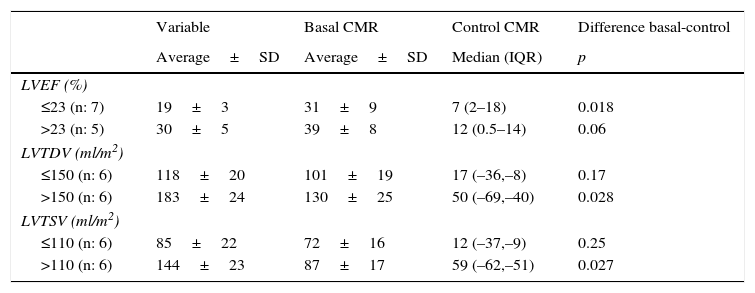To assess pre and post-operative cardiac MRI (CMR) findings in patients with left endoventriculoplasty repair for ventricular aneurysm due to ischemic heart disease.
Material and methodsData were retrospectively gathered on 21 patients with diagnosis of ventricular aneurysm secondary to ischemic heart disease undergoing left endoventriculoplasty repair between January 2007 and March 2013. Pre and post-operative CMR were performed in 12 patients. The following data were evaluated in pre-operative and post-operative CMR studies: quantitative analysis of left ventricular ejection fraction (LVEF), left ventricular end-diastolic (LVEDV) and end-systolic (LVESV) volume index, presence of valvular disease and intracardiac thrombi. The time between surgery and post-operative CRM studies was 3–24 months.
ResultsSignificant differences were found in the pre and post-operative LVEF, LVEDV and LVESV data. EF showed a median increase of 10% (IQRP: 2–15) (p=0.003). The LVEDV showed a median decrease of 38ml/m2 (IQR: 18–52) (p=0.006) and the LVESV showed a median decrease of 45ml/m2 (IQR: 12–60) (p=0.008). Post-operative ventricular volume reduction was significantly higher in those patients with preoperative LVESV >110ml/m2 (59 and 12ml/m2, p=0.006).
ConclusionIn patients with ischemic heart disease that are candidates for left endoventriculoplasty, CMR is a reliable non-invasive and reproducible technique for the evaluation of the scar before the surgery and the ventricular volumes and its evolution after endoventricular surgical repair.
Valorar con resonancia magnética cardíaca (RMC) el resultado de la endoventriculoplastia y compararlo con los hallazgos prequirúrgicos en pacientes con miocardiopatía dilatada isquémica y aneurisma ventricular.
Material y métodosRevisamos retrospectivamente 21 pacientes consecutivos con miocardiopatía dilatada isquémica sometidos a endoventriculoplastia entre enero de 2007 y marzo de 2013. En 12 de ellos se realizó RMC pre- y posquirúrgica. En las RMC diagnóstica y posquirúrgica se hizo un análisis cuantitativo de la fracción de eyección (FEVI), volúmenes telediastólico (VTDVI) y telesistólico (VTSVI) del ventrículo izquierdo indexados, y se valoraron las valvulopatías y trombos intracavitarios. El tiempo transcurrido entre la intervención quirúrgica y los estudios de control con RMC osciló entre 3 y 24 meses.
ResultadosLa FEVI y los VTDVI y VTSVI pre- y posquirúrgicos fueron significativamente diferentes. La mediana de la FEVI aumentó el 10% (rango intercuartílico: 2–15) (p=0,003); la mediana del VTDVI disminuyó 38ml/m2 (rango intercuartílico: 18–52) (p=0,006), y la mediana del VTSVI disminuyó 45ml/m2 (rango intercuartílico: 12–60) (p=0,008). La reducción del volumen posquirúrgico fue mayor en pacientes con VTSVI basal>110ml/m2 (59ml/m2 y 12ml/m2, p=0,006).
ConclusiónEn pacientes con cardiopatía isquémica candidatos a endoventriculoplastia, la RMC es una técnica incruenta, reproducible y fiable para estudiar la cicatriz miocárdica antes de la intervención y los volúmenes ventriculares y su evolución tras la endoventriculoplastia.
Artículo
Comprando el artículo el PDF del mismo podrá ser descargado
Precio 19,34 €
Comprar ahora













